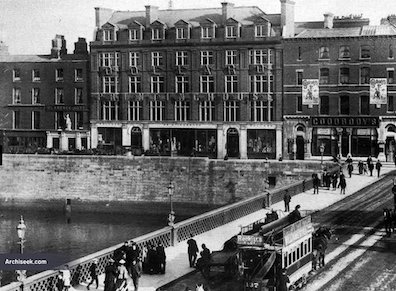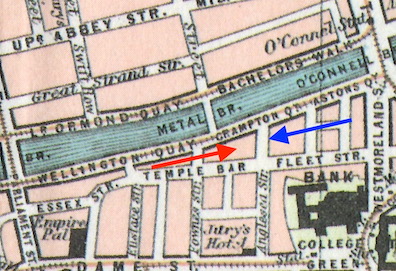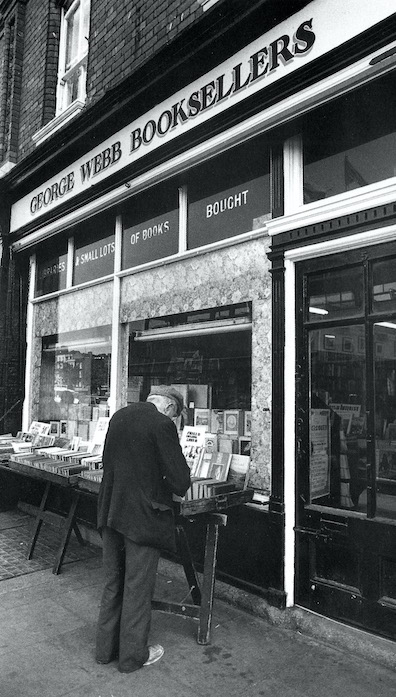In James Joyce's Dublin Ian Gunn and Clive Hart
suggest that the bookshop could possibly be Francis
Fitzgerald's at 1 Merchants' Arch and 15 Temple Bar, but they
think it is more likely on Wellington Quay. Ithaca
informs readers of Bloom's "bookhunt along Bedford row,
Merchants' Arch, Wellington Quay," with the suggestion
that he not only visited those streets but did so in that
order. Hart observes that it is "possible that the order given
in Ithaca is not correct. Early in Sirens
Bloom's progress down the quays contains a passage listing
establishments in the wrong order" (52). But if it is correct,
Bloom has moved west from Bedford Row along Temple Bar, turned
north through Merchants' Arch, and ended up on Wellington
Quay, from which he will be seen wending his way to the Ormond
Hotel at the beginning of Sirens.
Slote and his collaborators have much to say about a
particular bookseller's on this quay, noting that Joshua
Strong had ceased doing business by 1904 but was listed in
earlier editions of Thom's directory as a "foreign
bookseller and librarian at 26 Wellington Quay." They quote
from J.
F. Byrne's Silent Years: "Josh Strong was the
name of the man who owned the bookshop, and he was a Jew. In
the little window of the shop the passersby on Wellington Quay
could see a few selected books which had been hung in the
window with their pages spread at some illustrations with
popular appeal.... And hanging prominently in the window with
its pages open at a colored illustration of a fecund uterus,
was a small, thick book called Aristotle's Masterpiece"
(18-19). This of course is the book that Bloom thinks about
throughout the first paragraph of the section.
Strong's shop, Slote observes, "was a small area partitioned
off from Aaron Figatner's shop at the same address"––a fact
which coheres with one's impression that Bloom is standing in
a crowded little space, with the proprietor going in and out
through a "dingy curtain" to procure more books and talk to
some unseen woman in the back. Joyce's portrait of an
uninhibited and uncouth shopkeeper also fits with Byrne's
report: "Josh was a real 'card'––a veritable oddity even among
owners of second-hand bookshops in Dublin––and he didn't seem
to care about anything or anybody" (19). He had an elder
brother who ran a bookshop in nearby Merchants' Arch, and
Slote notes that the 1897 edition of Thom's directory
lists a John Strong who had "a bookshop at 15 Temple Bar and a
stall at Merchants' Arch, which is where Bloom had been
previously. By 1904, John Strong's business had been taken
over by Francis Fitzgerald"––the bookseller whom Gunn and Hart
identify as a possible alternative to one on Wellington Quay.
All the pieces of this particular puzzle appear to fit,
including the interesting detail that the Strongs were
Jewish––a fact which would suggest that Bloom likes to
patronize the shops of fellow Jews, even though he declines Dlugacz's
apparent invitation to fraternity in Calypso. Gunn and
Hart add one more interesting detail. The budget for Bloom's
day in Ithaca suggests that he does not buy Sweets
of Sin but instead "hires it––at notable expense: '1
Renewal fee for book 0.1.0'. Consider also Bloom's response to
the offer of Tales of the Ghetto: 'That I had'." The
entry for Fitzgerald's in Thom's directory, they note,
"contains no indication that he lent as well as sold books.
However, his predecessor at the same address, John Strong,
described himself and his business as 'bookseller and lending
library, book mart'." They do not provide any information
about Josh Strong, but it seems reasonable to suppose that he
may have operated on a business model similar to his
brother's.
Perhaps because the narrative of section 10 is so closely
linked with that of section 9, it contains yet two more
interpolations from the action of section 19 (making a total
of four across the two sections). The first of them references
a character already glimpsed in section 1: "On O'Connell
bridge many persons observed the grave deportment and gay
apparel of Mr Denis J Maginni, professor of dancing &c."
Hart notes that the mention of "many" people observing Maginni
sets up a contrast with the sentence that follows: "Mr Bloom,
alone, looked at the titles" (Critical Essays, 208).
The dancing master's gay apparel and flamboyantly public
display on the busiest bridge in town stand in sharp contrast
to Bloom, attired in black, closeted in a small shop,
privately preoccupied with the sexual appetites of his wife.
But the glimpse of Maginni on the bridge also should be set
beside his two other appearances in the episode. In section 1
he was seen on the northeast side of town,
heading south toward the river. Here he crosses it, still
moving south. In section 19 he will be spotted "Opposite
Pigott's music warerooms" at 112 Grafton Street. Surely some
kind of significant patterning is implied by this journey.
Father Conmee, emblematic of the Church, makes a long journey
to the northeast in section 1, greeting people all along the
way. The viceroy, ruler of the State, does the same in section
19, moving east and southeast and receiving salutes all the
way. Maginni's southerly journey, starting in section 1 and
ending in section 19, with a midpoint here in the midmost
section, also involves public display. He can perhaps be seen
as the representative of Art.
A second interpolation glances at the "elderly female"
glimpsed in the preceding section: "An elderly
female, no more young, left the building of the courts of
chancery, king's bench, exchequer and common pleas, having
heard in the lord chancellor's court the case in lunacy of
Potterton, in the admiralty division the summons, exparte
motion, of the owners of the Lady Cairns versus the owners
of the barque Mona, in the court of appeal reservation of
judgment in the case of Harvey versus the Ocean Accident and
Guarantee Corporation." This sentence comes immediately
after Bloom's response to The Sweets of Sin: "Young!
Young!" As in Calypso, where he seesawed between warm
sunlight and a warm bed and the despair of feeling old and
cold, here again Bloom hangs between vitality and senescence.
In section 19 the old woman is shown preparing to enter the
offices of Reuben J. Dodd, having walked down the King's Inn
Quay "Past Richmond bridge" and onto Ormond Quay Upper. In
section 10, however, she is seen leaving the Four
Courts building. This interpolation resembles the one in
the previous section that showed Richie Goulding walking
through the entrance hall of the Four Courts rather than
standing in the porch. Both interpolated actions occur
earlier, and therefore in slightly different spatial
locations, than the ones in section 19, where first Goulding
and then, seconds later, the old woman see the viceregal
cavalcade pass by. The order in which the actions are
presented imparts a sense of temporal succession within 9-10
and 19, and also between them.


